fuel pressure OPEL ASTRA SALOON 2014 Owners Manual
[x] Cancel search | Manufacturer: OPEL, Model Year: 2014, Model line: ASTRA SALOON, Model: OPEL ASTRA SALOON 2014Pages: 245, PDF Size: 7.12 MB
Page 27 of 245
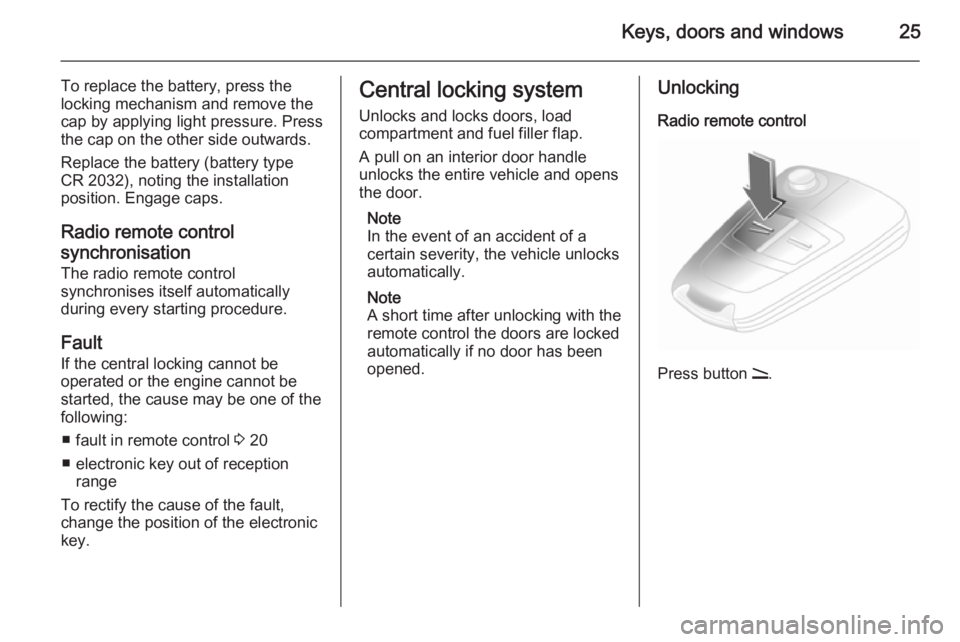
Keys, doors and windows25
To replace the battery, press the
locking mechanism and remove the
cap by applying light pressure. Press
the cap on the other side outwards.
Replace the battery (battery type
CR 2032), noting the installation
position. Engage caps.
Radio remote control
synchronisation The radio remote control
synchronises itself automatically
during every starting procedure.
Fault If the central locking cannot be
operated or the engine cannot be
started, the cause may be one of the
following:
■ fault in remote control 3 20
■ electronic key out of reception range
To rectify the cause of the fault,
change the position of the electronic
key.Central locking system
Unlocks and locks doors, load
compartment and fuel filler flap.
A pull on an interior door handle
unlocks the entire vehicle and opens
the door.
Note
In the event of an accident of a
certain severity, the vehicle unlocks
automatically.
Note
A short time after unlocking with the
remote control the doors are locked
automatically if no door has been
opened.Unlocking
Radio remote control
Press button q.
Page 102 of 245
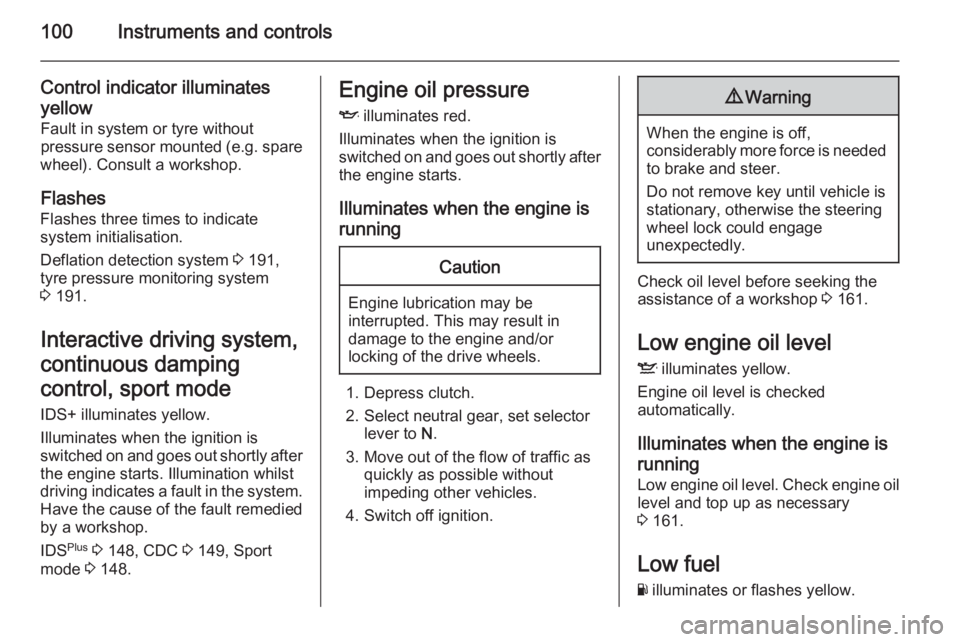
100Instruments and controls
Control indicator illuminatesyellow
Fault in system or tyre without
pressure sensor mounted (e.g. spare
wheel). Consult a workshop.
Flashes Flashes three times to indicatesystem initialisation.
Deflation detection system 3 191,
tyre pressure monitoring system 3 191.
Interactive driving system,
continuous damping
control, sport mode
IDS+ illuminates yellow.
Illuminates when the ignition is
switched on and goes out shortly after the engine starts. Illumination whilst
driving indicates a fault in the system.
Have the cause of the fault remedied
by a workshop.
IDS Plus
3 148, CDC 3 149, Sport
mode 3 148.Engine oil pressure
I illuminates red.
Illuminates when the ignition is
switched on and goes out shortly after
the engine starts.
Illuminates when the engine isrunningCaution
Engine lubrication may be
interrupted. This may result in
damage to the engine and/or
locking of the drive wheels.
1. Depress clutch.
2. Select neutral gear, set selector lever to N.
3. Move out of the flow of traffic as quickly as possible without
impeding other vehicles.
4. Switch off ignition.
9 Warning
When the engine is off,
considerably more force is needed
to brake and steer.
Do not remove key until vehicle is stationary, otherwise the steeringwheel lock could engage
unexpectedly.
Check oil level before seeking the
assistance of a workshop 3 161.
Low engine oil level
S illuminates yellow.
Engine oil level is checked
automatically.
Illuminates when the engine isrunning
Low engine oil level. Check engine oil
level and top up as necessary
3 161.
Low fuel Y illuminates or flashes yellow.
Page 156 of 245
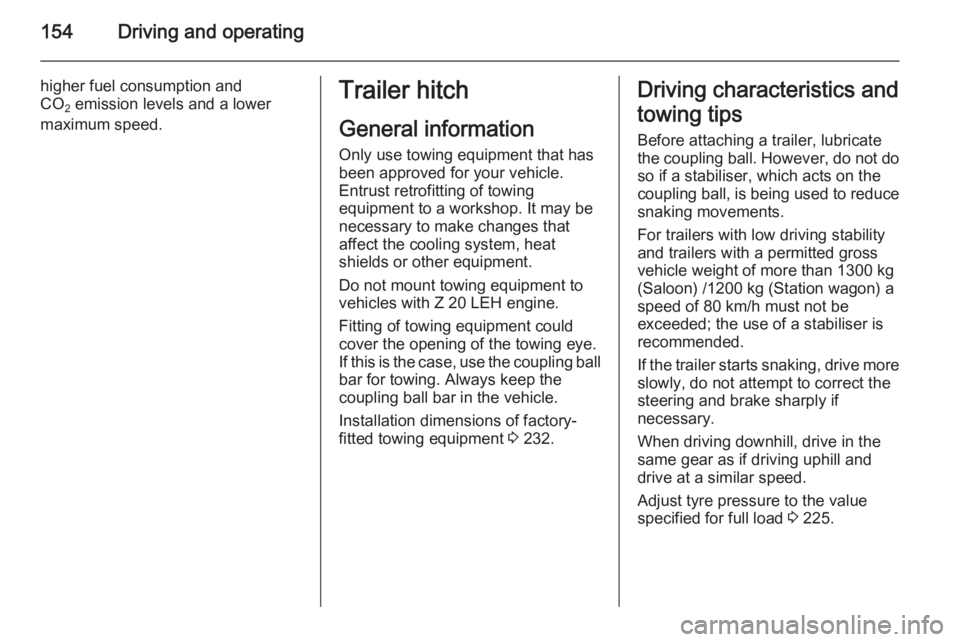
154Driving and operating
higher fuel consumption and
CO 2 emission levels and a lower
maximum speed.Trailer hitch
General information
Only use towing equipment that has
been approved for your vehicle.
Entrust retrofitting of towing
equipment to a workshop. It may be
necessary to make changes that
affect the cooling system, heat
shields or other equipment.
Do not mount towing equipment to
vehicles with Z 20 LEH engine.
Fitting of towing equipment could
cover the opening of the towing eye.
If this is the case, use the coupling ball bar for towing. Always keep the
coupling ball bar in the vehicle.
Installation dimensions of factory-
fitted towing equipment 3 232.Driving characteristics and
towing tips Before attaching a trailer, lubricate
the coupling ball. However, do not do
so if a stabiliser, which acts on the
coupling ball, is being used to reduce snaking movements.
For trailers with low driving stability
and trailers with a permitted gross
vehicle weight of more than 1300 kg
(Saloon) /1200 kg (Station wagon) a
speed of 80 km/h must not be
exceeded; the use of a stabiliser is
recommended.
If the trailer starts snaking, drive more
slowly, do not attempt to correct the
steering and brake sharply if
necessary.
When driving downhill, drive in the
same gear as if driving uphill and
drive at a similar speed.
Adjust tyre pressure to the value
specified for full load 3 225.
Page 161 of 245
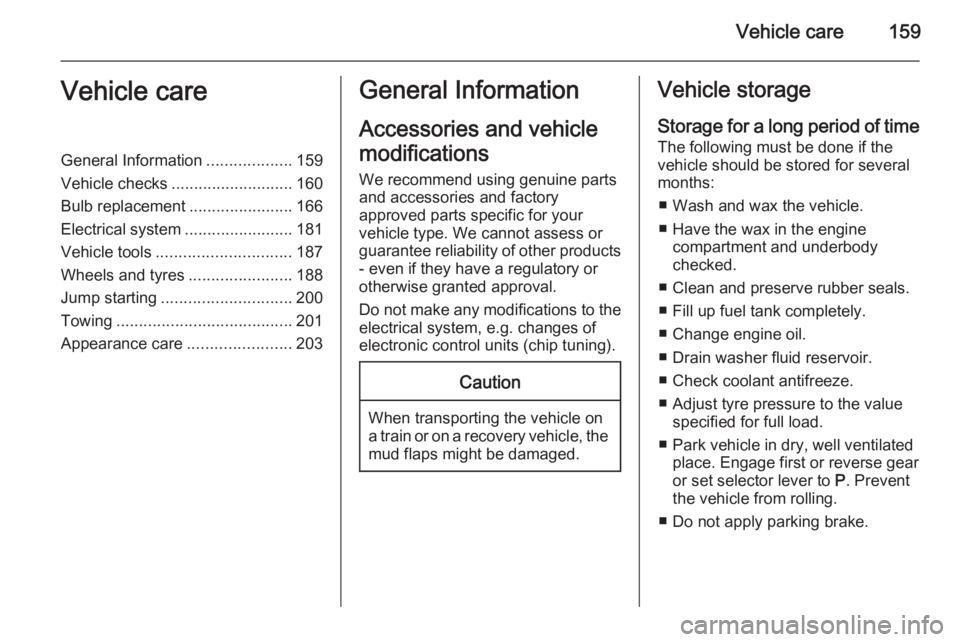
Vehicle care159Vehicle careGeneral Information...................159
Vehicle checks ........................... 160
Bulb replacement .......................166
Electrical system ........................181
Vehicle tools .............................. 187
Wheels and tyres .......................188
Jump starting ............................. 200
Towing ....................................... 201
Appearance care .......................203General Information
Accessories and vehicle
modifications
We recommend using genuine parts and accessories and factory
approved parts specific for your
vehicle type. We cannot assess or guarantee reliability of other products
- even if they have a regulatory or
otherwise granted approval.
Do not make any modifications to the electrical system, e.g. changes of
electronic control units (chip tuning).Caution
When transporting the vehicle on
a train or on a recovery vehicle, the
mud flaps might be damaged.
Vehicle storage
Storage for a long period of time
The following must be done if the
vehicle should be stored for several months:
■ Wash and wax the vehicle.
■ Have the wax in the engine compartment and underbody
checked.
■ Clean and preserve rubber seals.
■ Fill up fuel tank completely.
■ Change engine oil.
■ Drain washer fluid reservoir.
■ Check coolant antifreeze.
■ Adjust tyre pressure to the value specified for full load.
■ Park vehicle in dry, well ventilated place. Engage first or reverse gear
or set selector lever to P. Prevent
the vehicle from rolling.
■ Do not apply parking brake.
Page 192 of 245
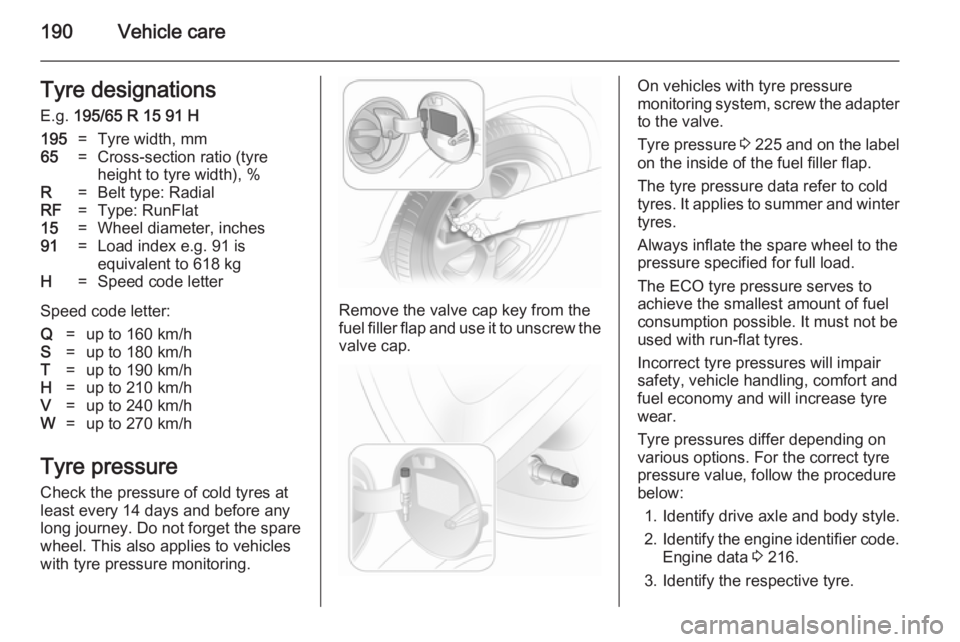
190Vehicle careTyre designationsE.g. 195/65 R 15 91 H195=Tyre width, mm65=Cross-section ratio (tyre
height to tyre width), %R=Belt type: RadialRF=Type: RunFlat15=Wheel diameter, inches91=Load index e.g. 91 is
equivalent to 618 kgH=Speed code letter
Speed code letter:
Q=up to 160 km/hS=up to 180 km/hT=up to 190 km/hH=up to 210 km/hV=up to 240 km/hW=up to 270 km/h
Tyre pressure
Check the pressure of cold tyres at
least every 14 days and before any
long journey. Do not forget the spare
wheel. This also applies to vehicles
with tyre pressure monitoring.
Remove the valve cap key from the
fuel filler flap and use it to unscrew the
valve cap.
On vehicles with tyre pressure
monitoring system, screw the adapter
to the valve.
Tyre pressure 3 225 and on the label
on the inside of the fuel filler flap.
The tyre pressure data refer to cold
tyres. It applies to summer and winter tyres.
Always inflate the spare wheel to the
pressure specified for full load.
The ECO tyre pressure serves to
achieve the smallest amount of fuel
consumption possible. It must not be used with run-flat tyres.
Incorrect tyre pressures will impair
safety, vehicle handling, comfort and
fuel economy and will increase tyre
wear.
Tyre pressures differ depending on
various options. For the correct tyre
pressure value, follow the procedure
below:
1. Identify drive axle and body style.
2. Identify the engine identifier code.
Engine data 3 216.
3. Identify the respective tyre.
Page 206 of 245
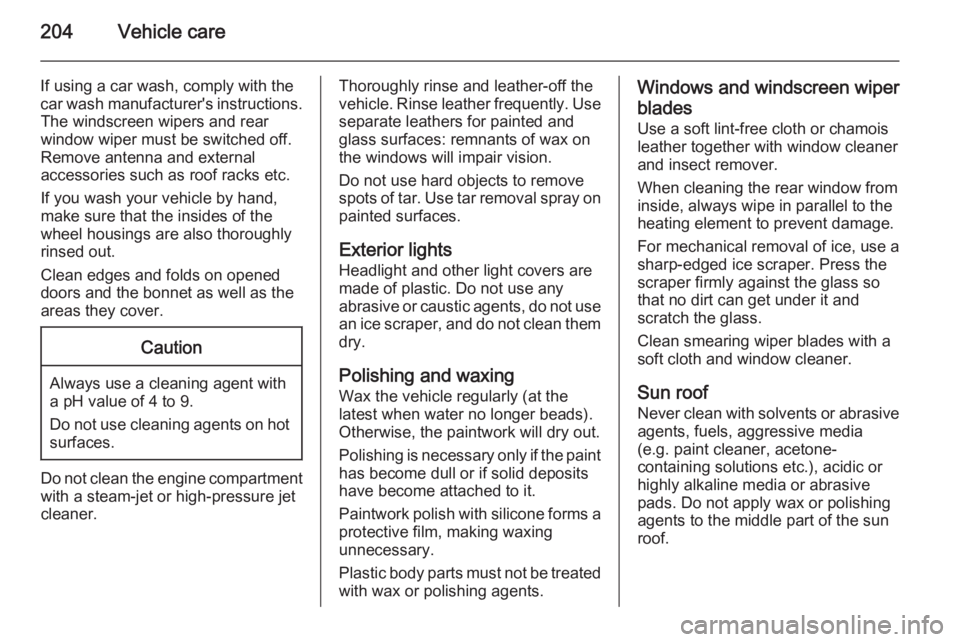
204Vehicle care
If using a car wash, comply with the
car wash manufacturer's instructions. The windscreen wipers and rear
window wiper must be switched off.
Remove antenna and external
accessories such as roof racks etc.
If you wash your vehicle by hand,
make sure that the insides of the
wheel housings are also thoroughly
rinsed out.
Clean edges and folds on opened
doors and the bonnet as well as the
areas they cover.Caution
Always use a cleaning agent with
a pH value of 4 to 9.
Do not use cleaning agents on hot surfaces.
Do not clean the engine compartmentwith a steam-jet or high-pressure jet
cleaner.
Thoroughly rinse and leather-off the vehicle. Rinse leather frequently. Use
separate leathers for painted and
glass surfaces: remnants of wax on
the windows will impair vision.
Do not use hard objects to remove
spots of tar. Use tar removal spray on
painted surfaces.
Exterior lights
Headlight and other light covers are
made of plastic. Do not use any
abrasive or caustic agents, do not use an ice scraper, and do not clean them
dry.
Polishing and waxing Wax the vehicle regularly (at the
latest when water no longer beads).
Otherwise, the paintwork will dry out.
Polishing is necessary only if the paint
has become dull or if solid deposits
have become attached to it.
Paintwork polish with silicone forms a
protective film, making waxing
unnecessary.
Plastic body parts must not be treated with wax or polishing agents.Windows and windscreen wiper
blades
Use a soft lint-free cloth or chamois
leather together with window cleaner and insect remover.
When cleaning the rear window from
inside, always wipe in parallel to the
heating element to prevent damage.
For mechanical removal of ice, use a
sharp-edged ice scraper. Press the
scraper firmly against the glass so
that no dirt can get under it and
scratch the glass.
Clean smearing wiper blades with a
soft cloth and window cleaner.
Sun roof Never clean with solvents or abrasive
agents, fuels, aggressive media
(e.g. paint cleaner, acetone-
containing solutions etc.), acidic or
highly alkaline media or abrasive
pads. Do not apply wax or polishing
agents to the middle part of the sun
roof.
Page 241 of 245
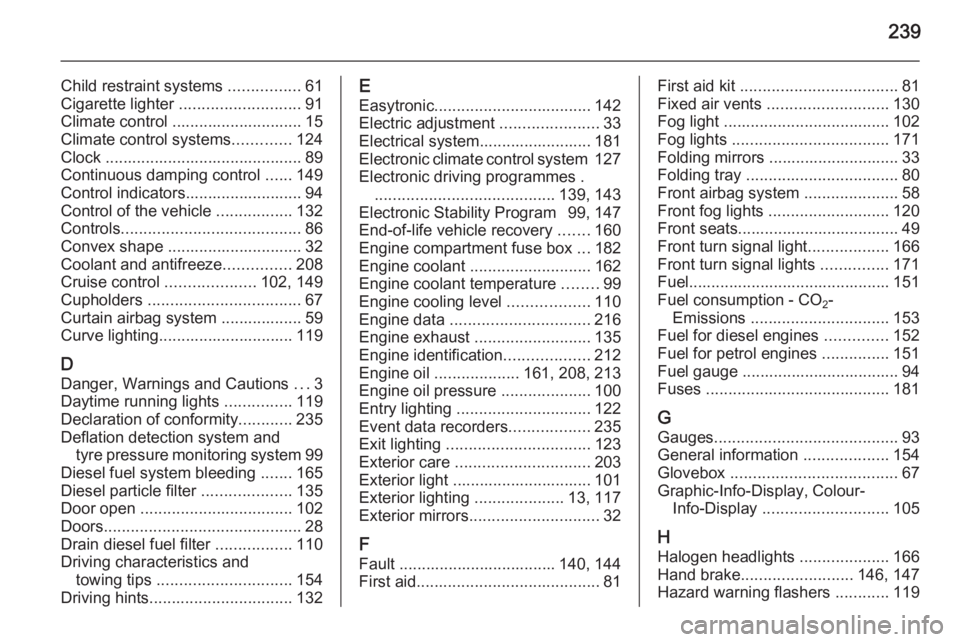
239
Child restraint systems ................61
Cigarette lighter ........................... 91
Climate control ............................. 15
Climate control systems .............124
Clock ............................................ 89
Continuous damping control ......149
Control indicators.......................... 94
Control of the vehicle .................132
Controls ........................................ 86
Convex shape .............................. 32
Coolant and antifreeze ...............208
Cruise control ....................102, 149
Cupholders .................................. 67
Curtain airbag system .................. 59
Curve lighting.............................. 119
D
Danger, Warnings and Cautions ...3
Daytime running lights ...............119
Declaration of conformity ............235
Deflation detection system and tyre pressure monitoring system 99
Diesel fuel system bleeding .......165
Diesel particle filter ....................135
Door open .................................. 102
Doors ............................................ 28
Drain diesel fuel filter .................110
Driving characteristics and towing tips .............................. 154
Driving hints ................................ 132E
Easytronic ................................... 142
Electric adjustment ......................33
Electrical system......................... 181
Electronic climate control system 127
Electronic driving programmes . ........................................ 139, 143
Electronic Stability Program 99, 147
End-of-life vehicle recovery .......160
Engine compartment fuse box ...182
Engine coolant ........................... 162
Engine coolant temperature ........99
Engine cooling level ..................110
Engine data ............................... 216
Engine exhaust .......................... 135
Engine identification ...................212
Engine oil ................... 161, 208, 213
Engine oil pressure ....................100
Entry lighting .............................. 122
Event data recorders ..................235
Exit lighting ................................ 123
Exterior care .............................. 203
Exterior light ............................... 101
Exterior lighting ....................13, 117
Exterior mirrors ............................. 32
F
Fault ................................... 140, 144
First aid ......................................... 81First aid kit ................................... 81
Fixed air vents ........................... 130
Fog light ..................................... 102
Fog lights ................................... 171
Folding mirrors ............................. 33
Folding tray .................................. 80
Front airbag system .....................58
Front fog lights ........................... 120
Front seats.................................... 49
Front turn signal light ..................166
Front turn signal lights ...............171
Fuel............................................. 151
Fuel consumption - CO 2-
Emissions ............................... 153
Fuel for diesel engines ..............152
Fuel for petrol engines ...............151
Fuel gauge ................................... 94 Fuses ......................................... 181
G
Gauges ......................................... 93
General information ...................154
Glovebox ..................................... 67
Graphic-Info-Display, Colour- Info-Display ............................ 105
H Halogen headlights ....................166
Hand brake ......................... 146, 147
Hazard warning flashers ............119